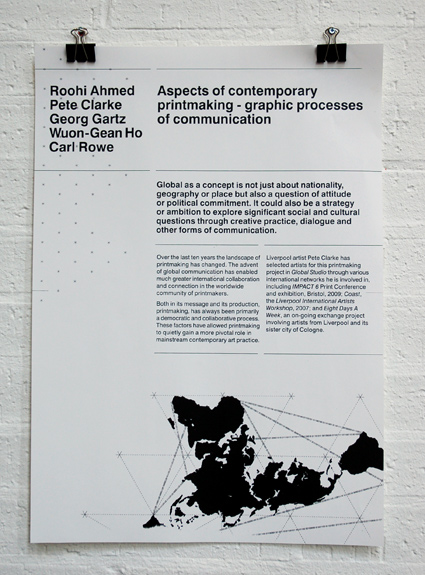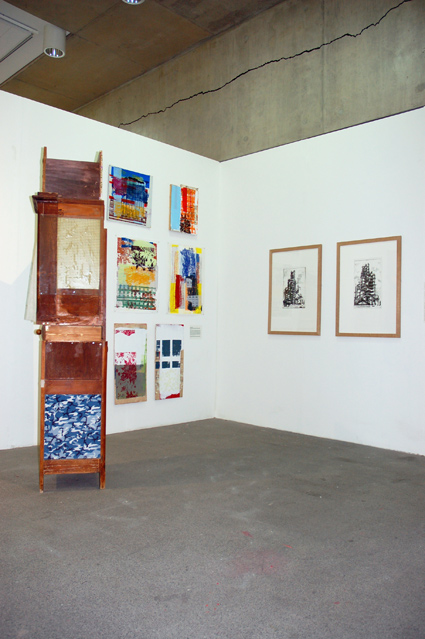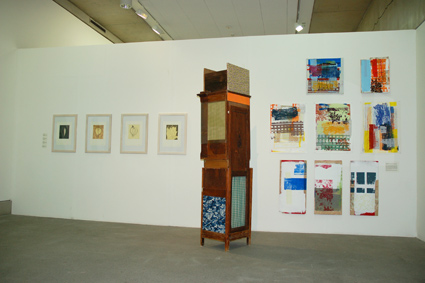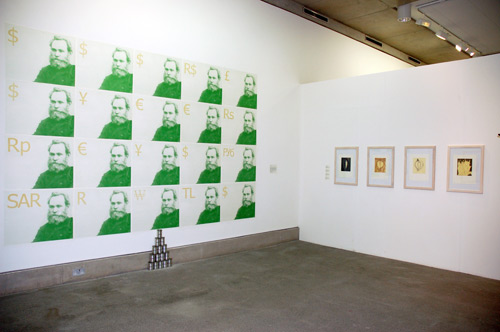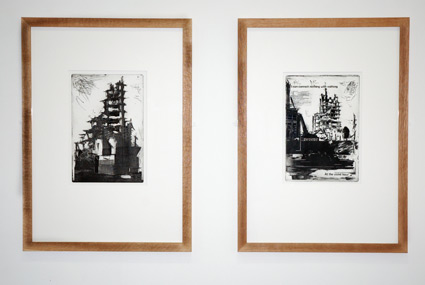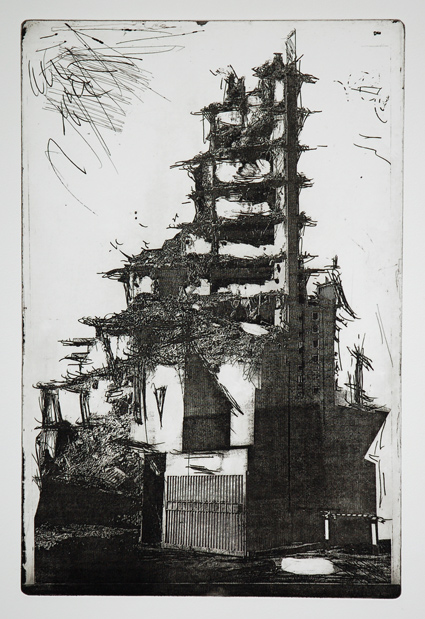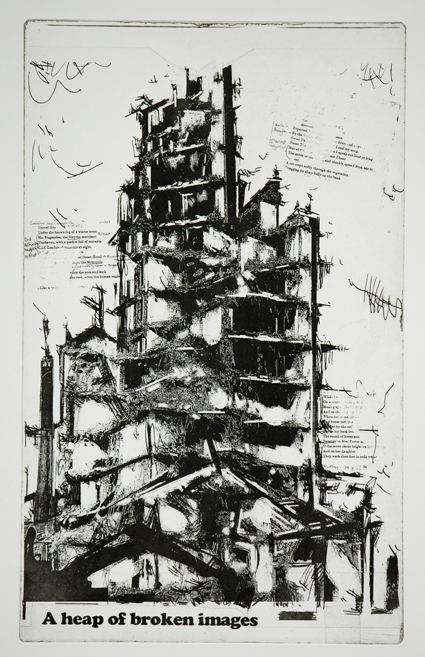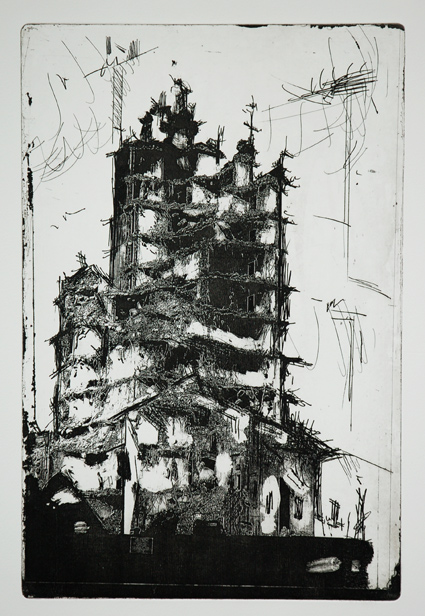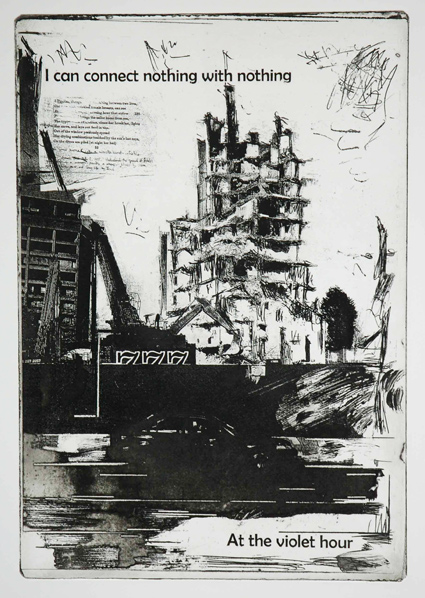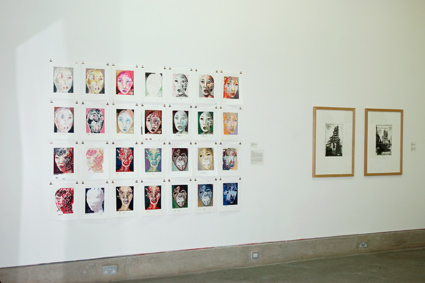| Pete
Clarke |
|||||||||||||||||||||||||||||||||||||||||
|
PETE CLARKE Mount Vernon A series of Etching and Photo-Polymer Prints A mixed metaphor initially based on an annotated found copy of T.S. Eliot Poems for the text combined with images from the demolition of the Piranesi-like nurses’ home on Mount Vernon, the hill rise behind the Royal Liverpool Hospital. Mount Vernon was the plantation home of George Washington, the first President of the USA. ‘There has always been an important influence from literature and on literary narrative as a stimulus for problems of communication. I collect old type and often use fragmented language in work, for example recent prints and drawings are influenced by finding a rather broken and torn copy of ‘The Waste Land and Other Poems’ by T.S. Eliot, an old Faber Paperback that has been annotated in beautiful pencil handwriting across the text by an anonymous author, in a valiant attempt to understand the meaning of the poems. It becomes visually and textually a fascinating conceptual document, not surprisingly then it has stimulated recent work’. GEORG GARTZ Lost and Found An installation of silkscreen prints combined with a reconstructed family cupboard remembering childhood experiences ‘His cultural outlook and means of production are based on the philosophical relationships between the act of making and creative addition with processes of negation and revision, that destruction can be a creative act. His working methods seek to establish the critical tension between rationality and the exploitation of accident by balancing systematic organisation with the orchestration of formal difference, in a sense he infects clear clean colourful surfaces and structures with viral mark making. This use of different paint qualities and textures with stencils and mono printing from found industrial surfaces and wallpapers generate new forms of hybridity in contemporary painting’. WUON-GEAN HO Masks Unmasked Colour trial proofs for works in the Mask Series In the silkscreen prints that make up the Mask Series, I explored the notion that we have much more history, emotions and attitudes in the make up of our true personality than can be conveyed by viewing the surface and texture of the face alone. I combined imagery from myth; concrete interactions; savage emotions and strong aspirations, in a blurring of traditional portraiture to a more symbolic one. Some of the small histories are described on the surface of the face, and others are hidden in shadows or ambiguous tattoo-like lines. The wall of prints that compose Masks Unmasked is about the numerous colour trial proofs that I made as I explored the themes and tried to isolate an image that was most intense and resonated with my personal aesthetic. The wall is an interesting insight into my thought process, from colour swatches and scribbled notes alongside the images to my handling and layering of colour. Much like a diary, it charts the choices and substance in the making of my work. CARL ROWE Drool Screen-print, ink containing 20 herbs and spices, tin cans Ivan Pavlov is remembered for his work with dogs, which led to the formulation of his theory on respondent conditioning. When a dog is habitually fed shortly after ringing a bell, it will salivate in response to the bell regardless of whether there is food or not. For Drool, a poster image of Ivan Pavlov has been screen-printed in a special ink comprising twenty herbs and spices derived from the G20 countries. Twenty posters are pasted on the gallery wall each representing one of the standard currencies of the G20. Below a triangular stack of tin cans is suggestive of capitalistic commerce and hints at Abram Maslow’s hierarchy of needs. The work should impart a feint sweet smell of spice. ROOHI AHMED Typhoon Etching, hard ground and aquatint Typhoon is about language and the subtleties of communication and understanding. The resulting dialogue is explored through a variety of media, research methods and the complexities of collaboration. The body of work encompasses images as metaphors, symbols or merely ‘figures of speech’ evolved from conversations that are either fluid or fragmented. The resulting works come together and yet remain distinct allowing for a holistic experience of expression. The understanding and inference of these works rests upon their constituent objects and words, however, the resulting ambiguities require the creative imagination of the reader to synthesise and complete the narrative.
|
||||||||||||||||||||||||||||||||||||||||
